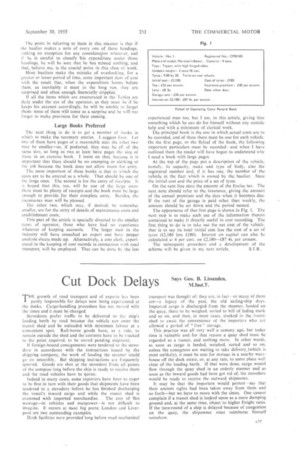Cut Dock Delays
Page 63

If you've noticed an error in this article please click here to report it so we can fix it.
Says Geo. B. Lissenden, M.Inst.T.
T"growth of road transport and of exports has been partly responsible for delays now being experienced at the docks. Cargo-handling procedure has not moved with the times and it must be changed.
Stevedores prefer traffic to be delivered to the ship's loading berth by road because the vehicle can enter 'the transit shed and be unloaded with minimum labour at a convenient spot. Rail-borne goods have, as a rule, to remain outside the shed and the contents have to be trucked to the point required, to be stored pending shipment.
If foreign-bound consignments were tendered to the stevedore in accordance with the instructions issued by the shipping company, the work of loading the steamer could go on smoothly. But shipping instructions are frequently ignored. Goods are shot at the stevedore from all points of the compass long before the ship is ready to receive them and the road vehicles have to queue.
Indeed in many cases, some exporters have been so eager to be first in turn with their goods that shipments have been tendered to a stevedore before he has finished discharging the vessel's inward cargo and while the transit shed is crammed with imported merchandise. The cost of this wastage—in vehicles and manpower—is not difficult to imagine. It occurs at most big ports; London and Liverpool are two outstanding examples.
Dock facilities were provided long before road mechanical transport was thought of: they are, ;n fact—or many of them are—a legacy of the past, the old sailing-ship days. Imported cargo is discharged from the steamer, landed on the quay, there to be weighed, sorted to bill of lading mark and so on, and then, in most cases, stacked in the transit shed to await the convenience of the importers who are allowed a period of " free" storage.
This practice was all very well a century ago, but today time is valuable and for that reason a quay shed must he regarded as a transit, and nothing more. In other words, as soon as cargo is landed, weighed, sorted and so on, unless the consignees are waiting to take delivery (which is most unlikely), it must be sent for storage in a nearby warehouse off the dock estate, or, at any rate, to some place well clear of the loading berth. If that were done, cargo would flow through the quay shed in an orderly manner and as soon as the inward goods had been got rid of, the stevedore would be ready to receive the outward shipments.
It may be that the importers would protest—say that their ancient rights had been taken away from them and so forth—but we have to move with the times, One cannot complain if a transit shed is looked upon as a mere dumping ground and, at the same time, 'object to higher freight rates. If the turn-round of a ship is delayed because of congestion on the quay, the shipowner must reimburse himself somehow.




























































































